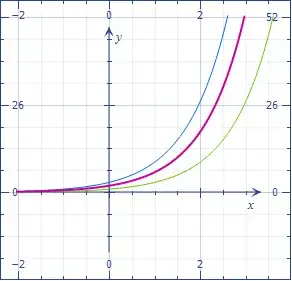Exponentiation turns addition to product, $$a^{b+c}=a^ba^c$$ (in the naturals, this is immediate from the definition). This corresponds to a "translation" property: shifting the argument amounts to a multiplication by a constant, and conversely, multiplying by a constant preserves the shape.
By definition, the slope of a curve is the vertical increment corresponding to an horizontal increment, and by the above property, the vertical increment must be a constant times the function. Hence the derivative of an exponential is an exponential.
More specifically,
$$\lim_{h\to0}\frac{a^{x+h}-a^x}h=a^x\lim_{x\to h}\frac{a^h-1}h$$ confirms this intuition.
Now we have this "magical" number $$\lim_{x\to h}\frac{a^h-1}h,$$ which is a priori a function of $a$. When $a=1$, this is $0$; when $a=10$ (say), numerical estimates based on $h=2^{-k}$ are $9,
4.32\cdots,3.11\cdots,2.67\cdots,2.48\cdots,\cdots2.3025\cdots$. They seem to stabilize above $1$.
It is possible (I will not attempt here) to show that the limit indeed converges to a value above $1$ for $a=10$, and that it is a continuous function of $a$. Hence, by the IVT, the must exist a constant, let $e$, such that
$$\lim_{h\to0}\frac{e^h-1}h=1$$
and
$$(e^x)'=e^x.$$
The plot below illustrates the relation between an exponential and its derivative, by showing
$$3^x,3^{x+1}-3^x,3^{x+1}.$$

One can also show that
$$e^x=\lim_{n\to\infty}\left(1+\frac xn\right)^n$$ is truly a power function and
$$e^x=\left(\lim_{m\to\infty}\left(1+\frac1m\right)^m\right)^x$$ (it suffices to substitute $mx$ for $n$), and the definition of the natural exponential just rests on the constant $e$.
